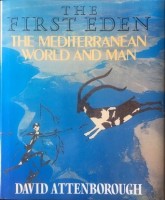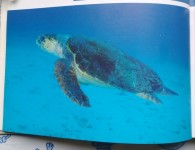 Title: The First Eden: The Mediterranean World and Man
Title: The First Eden: The Mediterranean World and Man
Author(s): David Attenborough
Release year: 1987
Publisher: Collins / BBC Books
Why in Database: In this book, dedicated to the Mediterranean, there are some turtle fragments + two nice pictures.
The first fragment is about two species of turtles, Leatherback Turtle and Loggerhead Turtle:
Other Atlantic animals also pay regular visits to the Mediterranean. The immense ocean-going leatherback turtle, which can grow to a lenght of six feet, whose global wanderings are still largely uncharted sometims appears in the Sea, drifting through the water lazily browsing on sholas of jellyfish. Loggerhead turtles, which are very smaller, come in to feed on the Posidonia meadows. Some haul themselves out of the water to lay theirs eggs in the sand of beaches around one or two of the Greek islands and along the remoter parts of the Turkish coast. A significant number have even become permanent residents and never leave the Sea at all.
The second mention is a description of a photo of a sea turtle (Loggerhead):
Newcomers to the Sea
Several groups of air-breathing land animals have produced species that have colonised the sea. The turtles, such as the loggerhead (below), are reptiles. They are able to stay below the surface for long periods, but eventually they have to come to the surface to breathe.
Another element is a mention that the islands have been inhabited by various animals, among others, turtles:
Certain it is, however, that soon after the refilling, all the islands of any size were inhabited by a range of animals that included between them mice and shrews, hedgehogs and deer, tortoises and land birds, and even hippopotamus and elephants. None, however, had any large carnivores such as lion or leopard, and the their absence was to become important.
The next piece is about Maltese turtles, comparable in size to those that live on the Galapagos and Aldabra today. The mechanism of such gigantism is also explained:
Other Maltese animals, however, had become giants. There was a huge swan with a nine-foot wing-span which, judging from the small size of the breast bone to which its flying muscles were attached, was probably almost flightless, a dormouse the size of a large rabbit, and tortoises full comparable in size to those living today on the Galapagos and on Aldabra in the Indian Ocean. Birds escape their land-bound enemies by flying, rodents by taking refuge down holes and crevices. Both these factors normally limit their size. But in the absence of all enemies, both animals are free to grow large. The swans probably had relatively few problems with food, since little else competed with them for their favoured diet of water plants, but this would not have been the case as far as the rodents and tortoises were concerned. Competition for limited food supplies, it seems, has a different effect on small species than it does on large ones. Individual undersized elephants may well survive when bigger ones starve; but a big mouse or tortoise is likely to be more successful at claiming a share of scarce grazing than a small one.
Przedostatni kawałek to wyjaśnienie dlaczego gady tak dobrze sobie radzą w klimacie morza śródziemnego, z jednoznacznym zaznaczeniem, że żółwie można znaleźć właściwie wzdłuż całego wybrzeża.
Reptiles, however, relish the summers. Their skins are watertight, so the danger of dehydration for them is a negligible one. Furthermore, they gather the heat they need to activate the chemistry of their bodies d ever it directly from their environment instead of using food to generate it as mammals do, so warm days give them more energy rather than robbing them of it. In consequence, reptiles of one kind o another are common. Tortoises are found around most of the Sea’s coastline.
The last piece is the second photo, it shows a “spur-thighed” turtle:
There are three species of tortoise of which the spur-thighed (3) is the mos widespread, being found in Greece, Turkey and Italy as well as along the African shore.


Author: XYuriTT
